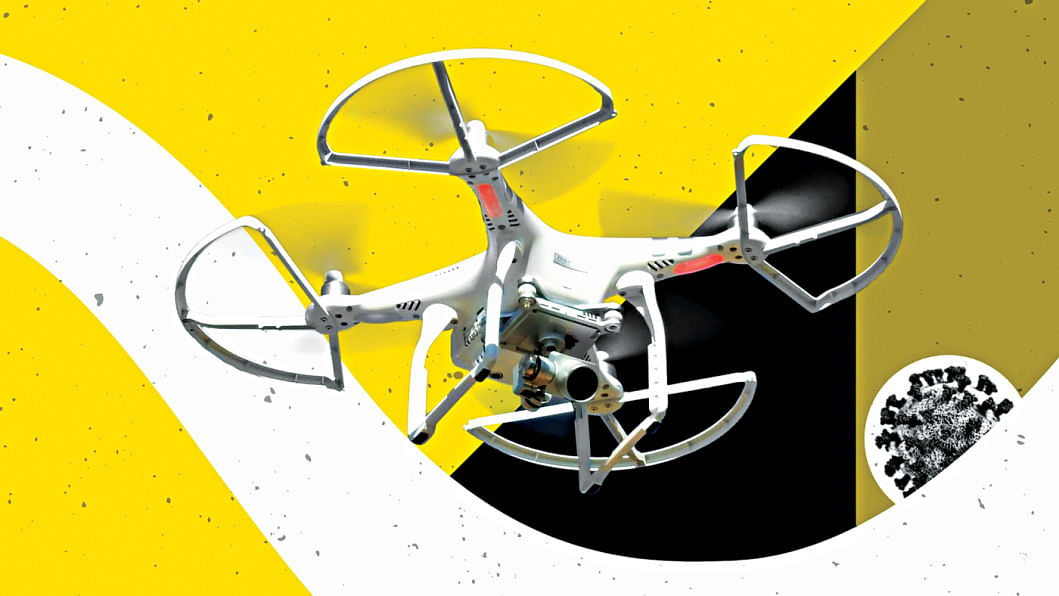Using drones against COVID-19

Cutting-edge technologies have been deployed to fight the spread of COVID-19 since the beginning of this pandemic. Drones have become one of the biggest allies to boost mass surveillance and to ensure social distancing all over the world. Public health officials, security forces and other officials in different countries such as China, India, Switzerland, and many more are using drones for urging people to avoid trafficked areas to deter potential infection. We take a look at how drones are coming handy in the fight against the pandemic and the scopes of using drones in Bangladesh.
Surveillance
To reduce people-to-people contact and the risk of getting infected to police officials and other staff, drones enable monitoring vast swathe of an area without physical engagement. This trend began in China and now this technology is being used by law enforcing authorities in many countries to make citizens aware about the government guidelines on lockdown and social distancing and to record the movement of violators. But the use of drones for surveillance raises the questions whether they do a privacy breach or violate property rights.
In Bangladesh, only the Chattagram Metropolitan Police (CMP) has taken such an initiative to monitor unnecessary gatherings and identify the culprits, but the tech is being used in a very limited scope.
Delivery services
Social distancing or quarantine life cannot confirm the protection from coronavirus if people go out to buy essentials or come in close contact with deliverymen. On the other hand, doctors and hospitals now need medical supplies in a safer and faster way more than ever. Drones can make this type of lengthy supply chain short with a maximum 60 to 100 miles per hour and absolutely no traffic to weave through. These drones are more relevant in the red zones of COVID-19 where outside physical contact should be minimized as much as possible.

Disinfectant spraying
According to DJI (the world's largest drone making company), a typical spraying UAV can carry around 16 litre of disinfectant and it can cover 100,000 square meter area per hour. Spraying disinfectants with drones is 50 times faster than traditional methods. These spraying drones are quite cheaper than the other drones and easy to handle. They can be mobilized easily and they also reduce the risk of health and sanitation workers getting exposed to both the coronavirus and the chemical disinfectants. Countries like Indonesia, India, Chile, Colombia, the Philippines, and the UAE have successfully used these disinfecting drones.
Temperature check
During the peak of the outbreak of coronavirus, Chinese authorities used thermal drones to measure people's temperature in quarantine. At that time, the situation was out of control and it was not possible to test the individuals of this vast population. These drones UAVs have thermal scanners to detect the heat or temperature. However, thermal drones are being developed so that these can specifically detect fever and also detect heart rate, respiratory rate, sneezing. Draganfly is already working on such drones called 'Pandemic drones'. However, there are many things that need to be clarified by this company and privacy concerns are expressed by the experts over its claims.
Is there any scope of using drones in Bangladesh amid this pandemic?
Abu Al Arabi, a Robotics researcher at BUET, said, "It's been quite a long time since the drone technology has become feasible. But when it comes to the point of realizing drones in Bangladesh amid such a pandemic, three core problems may appear. The first obstacle is due to the nature of drones as these are best suitable for outdoor and open-space applications, and not for congested areas like ours. The second one is due to our existing infrastructures, which is not orderly oriented. And the third problem is the monitoring issue because our existing AI and machine-learning tools are not well-developed to handle such an advanced system. I am optimistic that, concerning highways or fields, drone tech may play a vital role and will be efficient. But cases like the shopping malls, markets, or local areas which are the most vital places for social distancing to be maintained properly may induce collapse in executing drones for securing social distancing. Moreover, these types of congested areas introduce another issue, which is hazards from drones and hazard to drone itself. Hence, such scenarios will require much more research, effort, and time. For the time being, hopefully, CCTV footage will play a big role in such cases."





Comments